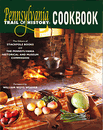Maple Sugar & Syrup
This article originally appeared in Pennsylvania Trail of History Cookbook
No one can be certain when or how the sweet taste of maple sap was discovered, or how the Native Americans learned to boil it into syrup and sugar, but there is little doubt that native people taught frontiersmen how to produce it. By 1790, maple sugaring was an established industry in Pennsylvania and provided a winter "crop" for many farmers during their slow season. A sugar maple could produce 2 to 3 gallons of liquid per day, which farmers collected into horse-drawn tanks. The sap was boiled over a fire into syrup, some of which was stirred into sugar that would harden into a cake. Further stirring caused it to form granules. The procedure required little equipment at the sugar camps, which remained relatively primitive, as they were used for only a brief period each year. Later, primitive sheds were built, some with a cupola in the roof to vent the steam.
Much of the early production ended up as maple sugar, which was easier to transport and could be converted back to syrup after reaching its destination. A less costly alternative to cane sugar, maple sugar became an important commodity used for sweetening or curing food. During the late nineteenth century, when cane sugar became available at a competitive price, farmers began to market maple syrup as a perfect complement to pancakes * or griddle cakes * and other foods. Today maple syrup, maple candy, and dishes made with maple products, such as maple sugar pie * and burnt sugar cake *, continue to be popular.
In 1992, the Somerset Historical Center in Somerset County constructed a historically accurate replica of a mid-nineteenth-century sugar camp, featuring authentic maple sugar-making tools and equipment from the center's collection. Somerset County still leads the commonwealth in the production of maple sugar products.
* Recipes for these maple dishes are available in the Pennsylvania Trail of History Cookbook
Visit
Somerset Historical Center, Somerset, PA
Interpretation of the rural life of southwestern Pennsylvania
For Further Reading
 |
Pennsylvania Trail of History Cookbook Edited by Kyle R. Weaver, Diane B. Reed, and Fred Lauver Forward by William Woys Weaver Stackpole Books and Pennsylvania Historical and Museum Commission 2004 |
 |
Somerset Historical Center: Pennsylvania Trail of History Guide by Lorett Treese Stackpole Books and Pennsylvania Historical and Museum Commission 2004 |




